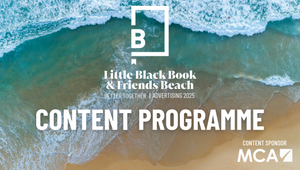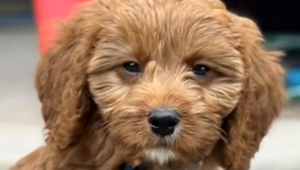
Publicis Groupe Is Thanking 100,000 Employees Personally - Here’s How They’ve Done It

When Arthur Sadoun decided that he wanted to thank every single person in Publicis Groupe individually, the reaction ranged from serene to freaked out. With 100,000 people to get round, the options were either to set up 273 meetings every day for a year or artificial intelligence. And while Arthur’s relentless energy is without question, well, that number of Zoom calls would probably constitute a ‘cruel and unusual punishment’ under the Geneva Convention. So AI it was.
The one slight issue, of course, was that AI video - particularly to that scale and level of personalisation - is very much in its infancy. As anyone who has seen some of the Hieronymus Bosch-esque experiments from last year - like this nightmarish spec beer ad - knows, unstable barely covers it.
But the desire to sincerely thank the Publicis Groupe community was so strong that the team knew they had to be bold and ambitious, grab the nettle of the rapidly-evolving-technology by its rapidly-evolving thorns. Every January, Publicis Groupe CEO Arthur issues a new year ‘Wishes’ video, often with a topical twist - and this year’s was the most technically challenging yet.
As the Groupe’s chief strategy officer and CEO of Publicis New York, Carla Serrano explains, despite the global challenges facing the industry at large, Publicis Groupe fared well, a testament to the hard work of everyone involved. “2023 was a pretty exceptional year for us. Number one in organic growth, number one in new business, number one in ESG, to be able to add purpose while we’re growing commercially, and then really, most importantly, to be able to be number one in market cap. This was the moment - I think we all wanted this and there hasn’t been much change within the industry, so for us, this was a huge achievement,” she says. “Obviously to be able to do this, it takes every single person that works in Publicis Groupe.”
Getting started, they had to assemble a team of creatives, tech experts and digital producers to figure it out. What made the project particularly challenging was that the team not only had to contend with new technologies, but technologies that are leveling up weekly.
As Andy Bird, CCO at Publicis Groupe’s Le Truc explains, this proved to be particularly challenging for the creatives as it meant that the concept was constantly being tweaked to keep up with what was possible.
“It’s been a fascinating journey to get where we are with it… the technology was evolving as we were doing it. Sometimes, some of our partners will say, ‘well, in two weeks’ time you can do this’,” he says. Sometimes, the team would dream up ideas and when they asked their tech partners if they were possible, the response wasn’t ‘no’, it was ‘not right now’. “We were evolving the concept to match the technology - even up to three or four weeks, we were still doing that. We wrote a base script, which kept on changing. The big thing here that is really new, is that this technology exists but stitching it together to make one piece of communication is something that hasn’t been done before.”
There was no set roadmap, and with numerous AI partners and technologies at hand, each with their own capabilities, strengths and weaknesses, this project was very much an experiment. From Publicis Groupe’s own platforms like Marcel and its ‘safe sandbox’ Publicis GPT to Nvidia, OpenAI, Stability AI, 11ElevenLabs and more, there was a lot of trial and error to find the right tool for the right job. For example, they found that when it came to the ability to generate in multiple languages, 11ElevenLabs offered the largest number of languages despite not being the most advanced technology.
What Andy and Carla have found is that AI has its strengths and weaknesses - and nowhere is that more apparent than in joke writing and humour. Androids may dream of electric sheep, but probably not of electric chickens crossing the road.
“Some things work better than others - some of the jokes from Chat GPT… some are funny, some aren’t so funny,” says Andy. “It’s been a real learning curve for us all creatively. What I have learned is that it’s going to be an addition to our creative toolbox, that the AI is not going to take our place. This is going to make us better, I think, and this technology is only going to get better.”
With hundreds of thousands of jokes generated, there’s no way to craft and hone the final outputs, and that’s been a huge exercise in letting go for the creatives. “You’ve kind of got to put trust in it and let go, which is the hardest thing for a creative person - to go, ‘actually, I can’t control this’.” says Andy. “We train it but what it does is its own thing.”
The jokes weren’t the only really challenging aspect of the project. Had they decided to simply create an AI twin of Arthur, and have him talk to the camera in the relevant language for each employee and slip their name in, that would have been… fine. But instead, the videos bring in multiple guest stars, from Carla to the likes of Maurice Levy, chairman of the supervisory board of Publicis Groupe and former CEO, Agathe Bousquet, president of Publicis Groupe France, Nigel Vaz, CEO of Publicis Sapient, and Dave Penski, CEO of Publicis Media. Not only that, but each guest star features in AI-animated cutaway scenes that reflect the recipient’s personal interests. That meant getting senior execs in the recording booth for an hour at a time to train the AI on their voices.
Some of these cutaway scenes still have that familiar, unstable characteristic of AI video - one scene of Carla climbing Mount Kilimanjaro in the example video shared with press sees her suddenly sprout three heads, as Andy Bird gleefully points out. But others are fluid and verging on lifelike.It will serve as a timestamp for where AI video is right now, the early 2024 equivalent of 32-bit graphics. It’s not perfect - reportedly, Arthur isn’t convinced his twin sounds anything like him - but that’s the point. This is about getting to grips with the nuts and bolts of the technology so they’re ready to work with it as it gets better and better by the month.
Ultimately, says Carla, playing it safe just wouldn’t be very on brand. “It was getting so hard that there was a moment in, I think November, where we said, ‘can we just cut this thing and do Arthur jockeying with different languages?’… It’s not very Publicis, is it? I feel like a perfect AI film where people already know that the technology can do that would not have been the right thing to do. Because that’s not what AI is all about. Again, this is with our people, so if you can’t experiment with your own people and have a practice of that… I also think that we really do want to encourage everybody because the technology is moving so quickly. You’ve just got to learn it, you got to practice and be comfortable with it. So hency that’s why there’s multiple people and we decided to go a little further.
Doing something as tricky as getting AI to write your jokes or turn your C-suite into ballet dancers and sky divers is a big statement. It’s a smart idea to experiment on your own brand and with your own people before you take it to clients, figuring out what works, what doesn’t and how to set boundaries.
“There’s no quality control over those 100,000 [videos]. So, in the spirit of really trying to master and get ahead of AI video and how to work with this sort of technology, to be able to experiment within our safe space, I think was really important,” says Carla.”It is really interesting because [for] many of our clients, the promise of AI and personalisation at scale (which is ‘I want to send my customers and prospects each a personal ad or content’) has been the dream of every marketer, right? If we know a little bit more about them, we can be more personal but the cost efficiencies to actually do it, in terms of effort, has been too arduous and then all of a sudden, with AI, that’s the potential.”
“This was our first real foray into a pretty ambitious project,” she adds, before chuckling, “we’ve seen some pretty bad jokes, though.”
And clients have definitely been intrigued. It’s not the first time that Publicis Groupe has essentially demoed its boundary-pushing tech capabilities with an internal project. And it’s a smart sell - a display of confidence and also a show that they’re not asking clients to take leaps that the Groupe would not take itself.
“The clients that we’ve told [about this] are incredibly impressed,” says Carla. “As you know, we did Marcel and we’re building a Marcel inside Pfizer. As much as this is absolutely about thanking our people, we know that this is a service that we can now help our clients deliver, whether it is internally within their organisation or externally to their customers and prospects.”
And this project has had some unexpected consequences internally too. Not only are creatives, tech experts and producers getting hands on with different AI tools, they’re building new ways of working and cooperating.
“It’s been fantastic for our more traditional creatives who’ve been working on this to learn what’s possible - and, actually, for our coders and tech people to work with us and to understand how to tell a story has been really good for them as well,” says Andy. “It’s been a real marriage of disciplines.”
The lessons that the team has learned on this have been invaluable. They’re figuring out, for example, how to build out their video and image prompting capabilities - this project has demonstrated that while prompting for ideas or headlines is something that’s relatively straightforward, moving image and visuals require more technical expertise and a grasp of the subtleties of different systems. They’re also working out how timelines differ between traditional filmmaking and AI - something that might take five minutes to fix in an edit suite could take a week as it has to be implemented across 100,000 different iterations. On the other hand, adding a new language can be a cinch; Andy jokes that it took Arthur’s AI twin 30 minutes to learn Korean.
Today, ‘Wishes 2024’ is sure to spark laughter, shock, bemusement and a lot of sharing across the Groupe’s 100,000-strong community. And tomorrow? Well it’s a project that’s helping to make sure that everyone at the holding company is match fit and ready for the AI opportunities in the coming weeks, months and years.















